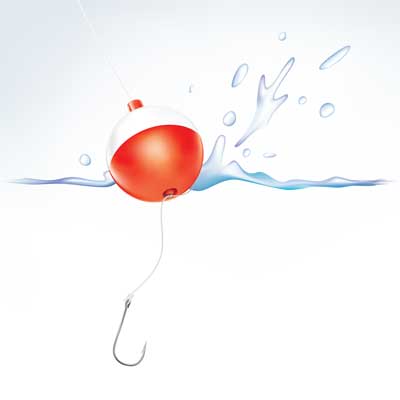Fishing Tackle – Floats and Bobbers

 Floats are also known as bobbers, corks and drifters. Some look to these bits of tackle with contempt. Others can’t get enough of them and rarely go out without using them.
Floats are also known as bobbers, corks and drifters. Some look to these bits of tackle with contempt. Others can’t get enough of them and rarely go out without using them.
Floats are perfect for maintaining a constant level from the surface, but this doesn’t mean it will keep a constant level from the bottom.
Available in a wide variety of shapes and sizes, fishing floats are designed for a particular fish or a particular weight and size of fish. Others for a specific type of fishing.
Float Fishing Tips
- The biggest mistake people make is having a float that’s too big for the target fish.
- Find a bobber that will pick up on the nibbles of the fish you’re trying to catch. If you’re trying to catch a fast biting fish like a smallmouth bass, a less sensitive float will work best.
- A float should be sensitive enough to allow the fish to pull the float under.
- Large bobbers tend to scare the fish away due to the resistance it offers.
You’ll find below an information guide for:
|
|
Floats for Spinning and Casting
The spinning bubble was created in the 1950’s in the US and is now found in various shapes and sizes aimed specifically for the fly casting anglers or those that prefer light gear.
The bubble is a simple float that allows water to enter it to change its buoyancy.
Carbonyte Float
These are small, sensitive floats with slender shafts of various sizes. Each bobber is marked indicating the size of the split shot it can take. These floats are highly versatile, sensitive and effective and should be a part of every angler’s tackle.
Fixed Floats
Fixed floats may be adjustable but they’re not recommended for casting with more than 5 feet from bobber to lure.
To get depths more than 5 feet, simply lower the line directly into the water.
The floating jig head is made up of a cork ball and is available either plain or dressed up with feathers, bucktail, plastic worms, grubs, leeches and other bait.
The great benefit of this type of float is that it’s easily constructed from a cork ball.
Sliding Floats
An interesting float as it offers greater versatility and allows the angler to reel the rig right up on to the rod tip. However for most types of fishing, fixed floats work best.
To fish with a sliding bobber, the line is threaded through the center hole. A float stopper is then added to prevent the float from traveling too far.
What makes the sliding float difficult to use is that any kind of knot, spring or other type of stopper will interfere with the line springing off the spool during the cast.
- Our recommendation is to stick to the fixed floats and avoid the sliding floats, especially for beginner anglers.
Active Float Fishing
Steelhead anglers use sinkers that bounce along rocky bottoms in a fast moving current.
Much like bottom rig supports, add a lightweight bobber near the lure to cause the bait to elevate, but not exceed the weight of the sinker.
Float Fishing the Bottom
This type of fishing will see the loss of many terminal rigs due to broken rocks, timber, stumps and other debris. The float enters the picture as it can keep the bait just above the debris. For fishing in areas that are over 15 feet deep, use a sliding float.
However, keep an eye on the bottom as debris rarely clears at the same level.
Depth Control
Summer can be the toughest time to catch any fish as their depth changes with the water temperature. Each species has its preferred thermal layer where they’re happy.
The best way to locate the fish is through a fish finder. Once located, set the float to the appropriate depth. Obviously, if you’re not catching anything, adjust your depth.
Fireballs
Submerged floats work well when surface conditions are rough. Fireball rigs are favored in the US east coastal states because the cork glows and attracts fish.
Bottom Rig Supports
Bottom rigs can be made to elevate above the bottom through the use of a small float, with the weight holding against the bottom.
Attachments
There are as many attachments as there are floats. Most allow for adjustment of the float without needing to have the float reapplied to the line. As with snaps, there are issues with secure and strong attachments.
Tip: Spring-loaded metal hocks, popular in circular bobbers, tend to crimp the line and these will cause problems with line strength and eventually lead to line breaks. Avoid these types of attachments.


